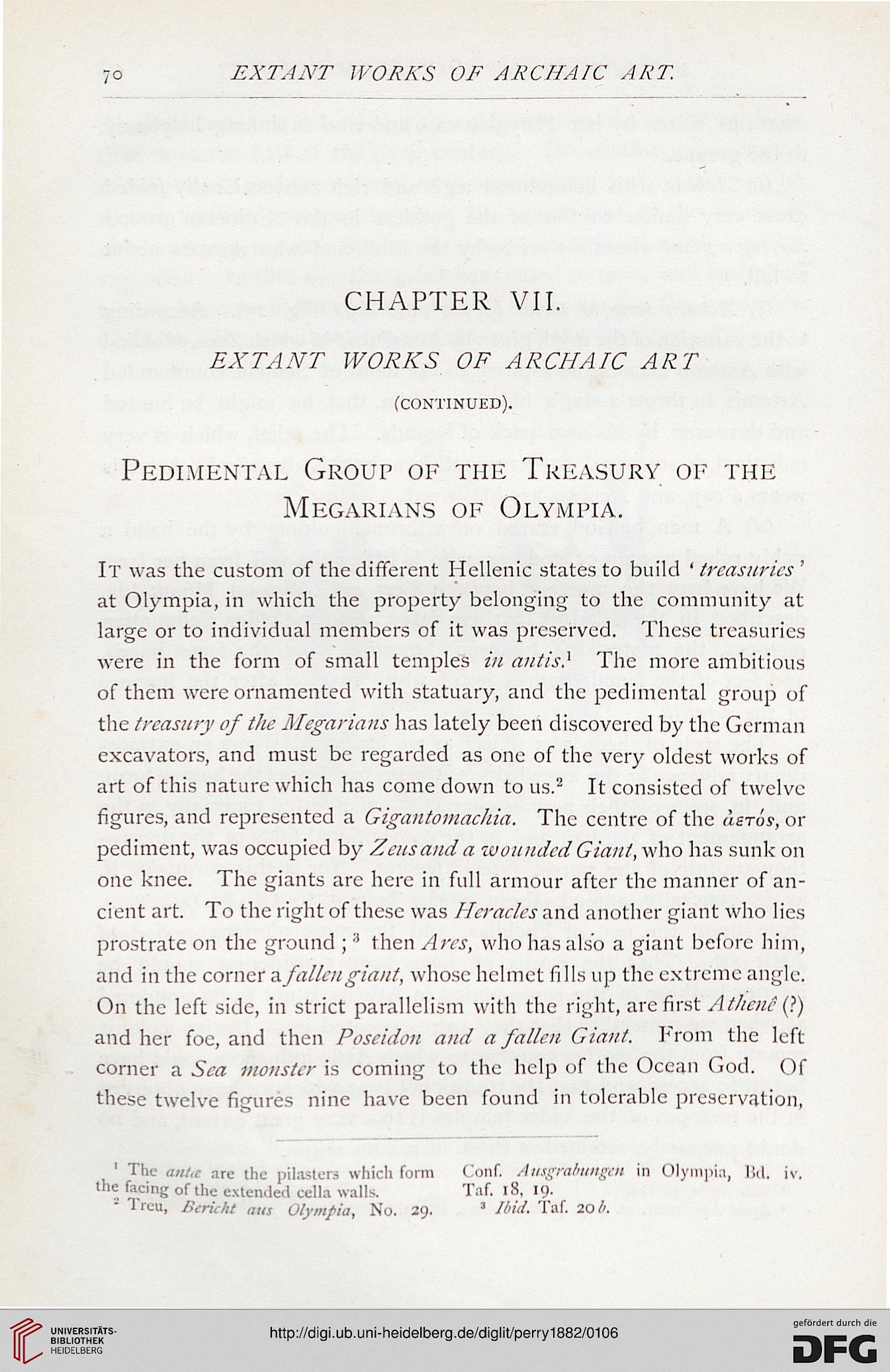70
CHAPTER VII.
EXTANT WORKS OF ARCHAIC ART
(continued).
Pedimental Group of the Treasury of the
Megarians of Olympia.
It was the custom of the different Hellenic states to build 'treasuries'
at Olympia, in which the property belonging to the community at
large or to individual members of it was preserved. These treasuries
were in the form of small temples in otitis? The more ambitious
of them were ornamented with statuary, and the pedimental group of
the treasury of the Megarians has lately been discovered by the German
excavators, and must be regarded as one of the very oldest works of
art of this nature which has come down to us.2 It consisted of twelve
figures, and represented a Gigantomachia. The centre of the dsros, or
pediment, was occupied by Zeus and a wounded Giant, who has sunk on
one knee. The giants are here in full armour after the manner of an-
cient art. To the right of these was Heracles and another giant who lies
prostrate on the ground ;:| then Ares, who has also a giant before him,
and in the corner a fallen giant, whose helmet fills up th c extreme angle.
On the left side, in strict parallelism with the right, are first A theni (?)
and her foe, and then Poseidon and a fallen Giant. From the left
corner a Sea monster is coming to the help of the Ocean God. Of
these twelve figures nine have been found in tolerable preservation,
' The atit.c are the pilasters which form Conf. AwgrnbUHgtH in Olympia, Bd, iv.
the facing of the extended cella walls. Taf. 18, 19.
- Ircu, Bcricht aus Olympia, No. 29. 3 </W& Taf. 20/>.
CHAPTER VII.
EXTANT WORKS OF ARCHAIC ART
(continued).
Pedimental Group of the Treasury of the
Megarians of Olympia.
It was the custom of the different Hellenic states to build 'treasuries'
at Olympia, in which the property belonging to the community at
large or to individual members of it was preserved. These treasuries
were in the form of small temples in otitis? The more ambitious
of them were ornamented with statuary, and the pedimental group of
the treasury of the Megarians has lately been discovered by the German
excavators, and must be regarded as one of the very oldest works of
art of this nature which has come down to us.2 It consisted of twelve
figures, and represented a Gigantomachia. The centre of the dsros, or
pediment, was occupied by Zeus and a wounded Giant, who has sunk on
one knee. The giants are here in full armour after the manner of an-
cient art. To the right of these was Heracles and another giant who lies
prostrate on the ground ;:| then Ares, who has also a giant before him,
and in the corner a fallen giant, whose helmet fills up th c extreme angle.
On the left side, in strict parallelism with the right, are first A theni (?)
and her foe, and then Poseidon and a fallen Giant. From the left
corner a Sea monster is coming to the help of the Ocean God. Of
these twelve figures nine have been found in tolerable preservation,
' The atit.c are the pilasters which form Conf. AwgrnbUHgtH in Olympia, Bd, iv.
the facing of the extended cella walls. Taf. 18, 19.
- Ircu, Bcricht aus Olympia, No. 29. 3 </W& Taf. 20/>.




